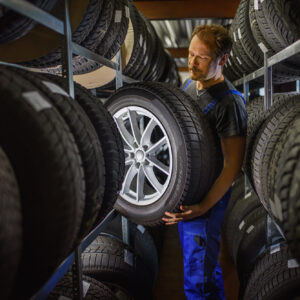At first glance, a set of tires might be the simplest thing you’ll find on an average vehicle. They’re round, rubber materials that don’t run on electricity or have any sort of wiring.
But if you’ve read enough books on auto parts, you’ll know that they’re more complicated than one might think一especially the low rolling resistance ones.
Tire Basics
Before we get into an in-depth discussion about low resistance tires, it’s important to understand the concept of tires as a whole.
Tires essentially act as shock absorbers whenever a vehicle travels over rough surfaces. They also create traction between the wheels and the road for handling purposes. Here are the parts that let tires perform these functions.

Tread
The tread is the part of the tire that touches the ground. It has a corresponding depth that indicates the need for a replacement when the tread gets shallow enough.
The tread also has grooves that have deep recesses to separate the tread blocks.
Sidewall
The sidewall is the part that sits between the tread and the wheel. This is where you’ll find the tire size and other construction details.
Bead
The bead serves as the foundation of the tire. It’s in the position where the tire grips the inside of the wheel rim.
Body Ply
The body ply is the main framework of the tire. It’s made up of several layers that wrap around the beads under the tread and sidewall rubber.
Belt
The belt consists of two or more layers that cover the body ply and underside of the tread. It helps stabilize the tread, increase its service life, and improve vehicle handling.
Inner Liner
The inner liner is the soft rubber lining inside the tire that protects the body ply. It also has self-sealing capabilities for small punctures.
Major Splice
The major splice is the stiffest part of the tire. It’s the overlapping point of the body ply, belt, and tread.
What Are Low Rolling Resistance Tires?
Rolling resistance is the effort your vehicle exerts to keep the tires rolling at a constant speed. It’s based on the phenomenon called hysteresis, a dynamic lag that results in energy loss whenever the tires roll.
A vehicle in transit puts its tires in a constant rolling state while carrying a load, deforming the treads in the process. Rolling resistance, although it consumes a notable amount of energy, is crucial to vehicle grip (traction) and performance.
If that’s the case, what’s the point of having low rolling resistance tires?
Tires with low rolling resistance essentially reduce the vehicle’s overall energy output when pushing through road surfaces.
Reducing rolling resistance can help the vehicle conserve energy, improving fuel economy. According to the US Energy Information Agency, a 10% reduction in rolling resistance can improve fuel economy by 1 to 2%.

What Are the Characteristics of Low Rolling Resistance Tires?
Low rolling resistance tires have several features that enable them to do their job. They include the following:
Tread Design
Low rolling resistance tires usually feature a contiguous and connected design that rolls as one unit. Unlike conventional and off-road tires, the tread blocks on low rolling resistance tires don’t connect to the road surface individually.
Tire tread composition in low rolling resistance tires has also been modified to become more energy-efficient than before. The tread tends to stay cool even when they’re rolling, using up less energy due to minimal heat.
Modified Sidewalls
The sidewalls on low rolling resistance tires are stiffer than conventional tires to reduce deformation when rolling, helping conserve energy.
Altered Contact Patch
Rolling resistance is to be expected from all tires regardless of their type. This means that they will always consume a certain amount of energy.
In the case of low rolling resistance tires, having a smaller tire footprint or contact patch is one way they’re able to conserve energy. Reducing the tire’s surface area by making it narrower can produce 40% less rolling resistance compared to regular tires.
Reduced Tire Weight
Low rolling resistance tires are lighter than conventional tires to help improve fuel economy. They share the same principle with losing cargo in the trunk so that the vehicle consumes less fuel while moving.
What Are the Disadvantages of Low Rolling Resistance Tires?
One of the biggest disadvantages of low rolling resistance tires is having less tire traction than regular tires.
Having less tire traction could mean greater stopping distances for a vehicle with low rolling resistance tires. It’s also possible for these tires to lose traction when moving over wet or slippery surfaces, increasing the risk of accidents.
Do Low Rolling Resistance Tires Wear Out Faster Than Regular Tires?
Although low rolling resistance tires tend to wear out faster than regular tires, the ultimate tradeoff is that they’re generally more fuel-efficient than their counterparts.
According to a report from the US Department of Energy, using low rolling resistance tires can result in a 10% fuel savings impact for many drivers.
Which Vehicles Have Low Rolling Resistance Tires?
Most hybrid and electric vehicles are sold with low rolling resistance tires as their stock tires.
Wrapping Up
Low rolling resistance tires are tires that have minimal contact with the ground when a vehicle is in transit.
Having low rolling resistance means the vehicle doesn’t exert too much effort for the wheels to move at a constant speed, which results in improved fuel economy.
However, it’s also important to note that low rolling resistance tires wear out faster than regular ones because they’re made to be narrower and lighter.
Driving with a set of low rolling resistance tires can also result in greater stopping distances and less traction when driving over wet or slippery roads.
Any information provided on this Website is for informational purposes only and is not intended to replace consultation with a professional mechanic. The accuracy and timeliness of the information may change from the time of publication.






























